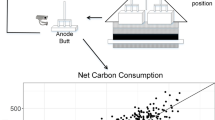Abstract
In the Hall–Héroult aluminum production process, the amount of carbon consumed per ton of aluminum produced is an important metric. Deviations from ideal conditions in the reduction cells contribute to the discrepancy between the theoretical carbon consumption and the actual Net Carbon Consumption (NCC). Previous work from the authors, focused on predicting the net carbon consumption for individual anodes using partial least squares, was based on data collected by an anode-tracking system. In this paper, the importance of each aluminum production step to the NCC is identified and a link to the green anode properties is established. The data collected were analyzed using the sequential multi-block partial least-squares algorithm. The data were split in different blocks, determined by the manufacturing process sequence. The modeling showed that the top three most important blocks were alumina feeding metrics, baked anode properties, and green anode properties. Local green anode homogeneity was defined as resistivity variability metrics, calculated from the green anode resistance measurements. This local green anode homogeneity was found to be greater for anodes with low NCC.
Graphical Abstract









Similar content being viewed by others
References
Natural Resources Canada (2022) Aluminum facts. https://www.nrcan.gc.ca/our-natural-resources/minerals-mining/aluminum-facts/20510. Accessed 16 May (2022)
Saevarsdottir G, Kvande H, Welch B (2020) Aluminum production in the times of climate change: the global challenge to reduce the carbon footprint and prevent carbon leakage. JOM 72:296–309
Grjotheim K, Kvande H (1993) Introduction to aluminum electrolysis, 2nd edn. Aluminium-Verlag, Dusseldorf
Khaji K, Al Qassemi M (2016) The role of anode manufacturing processes in net carbon consumption. Metals 6:128–139
Wilkening S, Reny P, Murphy B (2005) Anode cover material and bath level control. In: Kvande H (ed) Light Metals 2005. The Minerals, Metals & Materials Society, pp 367–372
Fischer W, Keller F, Perruchoud R (1991) Interdependence between anode net consumption and pot design, pot operating parameters and anode properties. In: Rooy E (ed) Light Metals 1991. The Minerals, Metals & Materials Society, pp 681–686
Mahieu P, Genin X, Bouché C, Brismalein D, Pédroli H (2019) Carbon block tracking package based on vision technology. In: Chesonis C (ed) Light Metals 2019. The Minerals, Metals & Materials Society, pp 1221–1228
Outotec ARTS(TM) anode and rod tracking system for primary aluminum smelters. https://www.outotec.com/company/media/news/2013/outotec-artstm-anode-and-rod-tracking-system-for-primary-aluminum-smelters/. Accessed 3 Mar (2021)
Musallam Al-Marzooqi M, Riasat T, Anode Rod tracking system for electrolysis plant. International patent application, Publication Number: WO/2016/097968
Manolescu P, Duchesne C, Tessier J, Saevarsdottir G (2020) Estimation of net carbon consumption in aluminum electrolysis using multivariate analysis. J Sustain Metall. https://doi.org/10.1007/s40831-020-00310-6
Ziegler DP, Secasan J (2016) Methods for determining green electrode electrical resistivity and methods for making electrodes. US Patent 9:416-458. 16 Aug 2016
Paris A, Duchesne C, Poulin E, Lauzon-Gauthier J (2020) Development of a soft sensor for detecting overpitched green anodes. In: Tomsett A (ed) Light Metals 2020. The Minerals, Metals & Materials Society, pp 1176–1182
Lauzon-Gauthier J, Secasan J (2021) Development and applications of the four points probe (4PP) electrical resistivity measurements for anode process optimization. In: Light met, pp 951–956
Geladi P, Kowalski BR (1986) Partial least squares regression: a tutorial. Anal Chim Acta 185:1–17
Kourti T, MacGregor JF (1995) Process analysis, monitoring and diagnosis, using multivariate projection methods. Chemom Intell Lab Syst 28:3–21
Chong IG, Jun CH (2005) Performance of some variable selection methods when multicollinearity is present. Chemom Intell Lab Syst 78:103–112
Lauzon-Gauthier J, Manolescu P, Duchesne C (2018) The sequential multi-block PLS algorithm (SMB-PLS): comparison of performance and interpretability. Chemom Intell Lab Syst 180:72–83
Westerhuis JA, Coenegracht PMJ (1997) Multivariate modelling of the pharmaceutical two-step process of wet granulation and tableting with multiblock partial least squares. J Chemom 11:379–392
Dunn K (2016) Process improvement using data 6.7. https://learnche.org/pid/. Accessed 10 May 2021
Acknowledgements
The authors acknowledge financial support of the Natural Sciences and Engineering Research Council of Canada (NSERC) [Grant Number RDCPJ 509004-17], Fonds de Recherche du Québec - Nature et Technologies (FRQNT) through the Aluminum Research Centre - REGAL, and Alcoa Corporation.
Author information
Authors and Affiliations
Corresponding author
Ethics declarations
Conflict of interest
The authors declare that they have no conflict of interest.
Additional information
The contributing editor for this article was Hojong Kim.
Publisher's Note
Springer Nature remains neutral with regard to jurisdictional claims in published maps and institutional affiliations.
Appendices
Appendices
Appendix 1: SMB-PLS Pseudo-code
See Table 3
Appendix 2: PLS Metrics
Within the PLS and SMB-PLS algorithms, two metrics can be calculated. One is the Hotelling’s \(\text {T}^\text {2}\) and it represents the distance from the origin to the projection of the point onto the latent variable space, shown in Eq. 6 [19]. That is to say, it is a measure of the variables’ magnitude. It is the sum of the squared ratio of the score value \(t_{i,a}\) to the standard deviation \(s_a\) of the score vector, where i is the observation number, and a the component number of the model using A components.
The second metric is the Squared Predicted Error (SPE) and it represents the distance from the model plane to the observation in high-dimensional space, calculated by Eq. 7 [19]. In other words, it is related with the correlation structure of the variables for each observation, as compared to the model. To calculate it the residual vector \({\textbf {e}}\) between the actual and predicted observation is used, where i is the observation number and a is the component number out of the A components of the model.
Appendix 3: List of Abbreviations for Figs. 7 and 8
Rights and permissions
About this article
Cite this article
Manolescu, P., Duchesne, C., Lauzon-Gauthier, J. et al. Net Carbon Consumption in Aluminum Electrolysis: Impact of Anode Properties and Reduction Cell-Operation Variables. J. Sustain. Metall. 8, 1167–1179 (2022). https://doi.org/10.1007/s40831-022-00556-2
Received:
Accepted:
Published:
Issue Date:
DOI: https://doi.org/10.1007/s40831-022-00556-2




